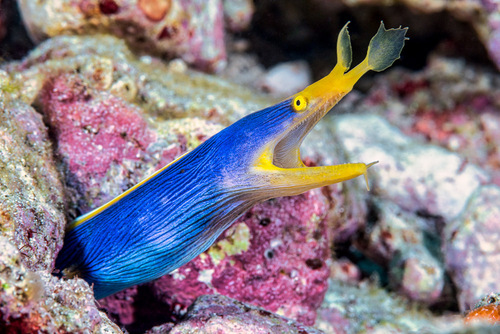
Ribbon Eel
The Atlantic bluefin tuna (Thunnus thynnus) is a highly migratory, large pelagic fish renowned for its size, speed, and commercial value. It plays a crucial role in the marine ecosystem as a top predator. This species has long fascinated humans, featuring in both ancient and modern cultures.
1 20 years
Lifespan
65 - 130 cm
Length
Least Concern
Conservation Status
Carnivorous
Diet
Local Migration
Migration
Appearance Overview
The Atlantic bluefin tuna is renowned for its large, streamlined body, built for speed and endurance.
Color
Dark metallic blue on top with a silvery underside
Fins
Two dorsal fins, the first depressible; short pectoral fins
Body
Torpedo-shaped, designed for efficient swimming
Length
Up to 13 feet (4 meters)
Weight
Up to 2,000 lbs (907 kg)
Diet
Carnivorous, feeding on fish, squid, eels, and crustaceans
Feeding Behavior
Uses speed to chase down prey, sometimes in coordinated schools, especially when younger.
Social Behavior
Forms schools, often segregating by size; highly migratory across vast oceanic distances.
Commercial Relevance
Extremely high value, particularly in sushi and sashimi markets, driving significant fishing pressure.
Conservation measures
Subject to international fishing quotas, stock management plans, and monitoring efforts; marine protected areas also play a role.
Status
Varies by population; Western Atlantic stock is considered endangered, while the Eastern Atlantic and Mediterranean stock has shown signs of recovery.
Threats
Overfishing (historically and ongoing), bycatch in fisheries targeting other species, climate change affecting prey distribution.
Habitat Distribution
Depth Range
0-1,000 meters (0-3,280 feet), but most commonly found in the upper few hundred meters.
Geographic Range
Atlantic Ocean, Mediterranean Sea, and formerly the Black Sea.
Preferred Environment
Pelagic, temperate, and tropical waters; prefers open ocean but can come closer to shore.
Reproduction and Life Cycle
Breeding Habits
Spawns in warm waters, with two main spawning grounds: the Mediterranean Sea and the Gulf of Mexico.
Development Stages
Eggs are pelagic, fertilized externally. Larvae are planktonic, undergoing rapid growth. Juveniles school and mature over several years.
Fecundity
Females can produce up to 30 million eggs per spawning season, depending on their size and condition.
Maturity Age
Varies by location; Western Atlantic stock matures around 8-12 years, Eastern Atlantic around 4-5 years.
Faqs about Ribbon Eel
How long do Atlantic bluefin tuna live?
They can live up to 40 years, although this is becoming rarer due to fishing pressure.
Are bluefin tuna warm-blooded?
Yes, they are warm-blooded, able to maintain a body temperature higher than the surrounding water, which aids in their speed and endurance.
How fast can Atlantic bluefin tuna swim?
They are among the fastest fish in the ocean, capable of bursts of speed up to 43 mph (70 km/h).
Is it safe to eat Atlantic bluefin tuna?
While generally safe, consuming large quantities of bluefin tuna can pose a risk due to mercury accumulation in their flesh.
Do Atlantic bluefin tuna migrate?
They undertake extensive migrations across the Atlantic Ocean for feeding and spawning.
Copyright @ Nature Style Limited. All Rights Reserved.
 English
English